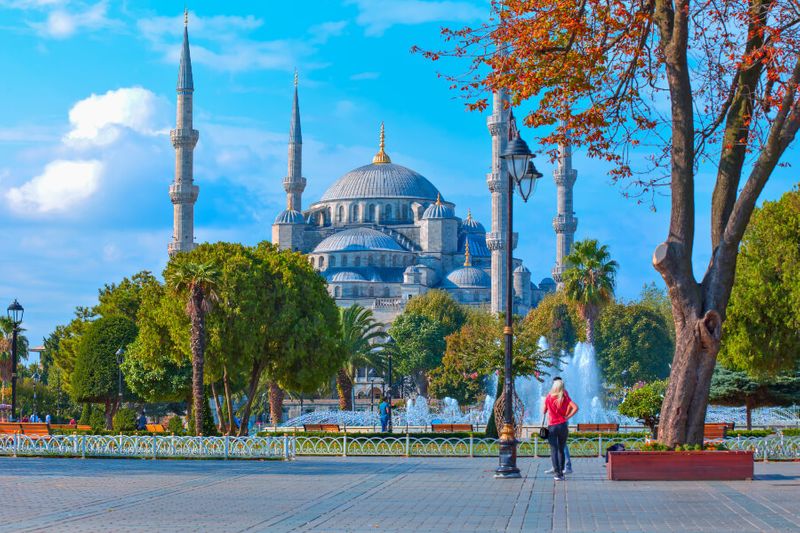Piercing the cosmopolitan skyline with its soaring turrets, the Sultan Ahmed Mosque is a symbol of Istanbul
The mosque is known colloquially as the ‘Blue Mosque’ due to its many sparkling aquamarine tiles. A more romantic story tells, those passing Ottoman sailors, enthralled by the reflection of the Marmara Sea, gave the mosque its name.
The Blue Mosque was built in just seven years, following the defeat of the Ottoman Empire at the hands of Persia in 1616. It was carefully placed near the Ottoman royal residence, the Topkapı Palace, and is built atop the vaults of the old Byzantine Grand Palace. Its placement at the imperial seat of the city reflects Sultan Ahmet I’s desire to reassert Ottoman power during this turbulent period.
The Blue Mosque’s symbolic placement also tells a story of the preeminence of Islam over Christianity, with the converted basilica Hagia Sophia cast in the shadow of the new mosque standing in opposition to it. Despite the implied critique to the church, the mosque borrows elements from Byzantine (Christian) design. This reflects the city’s cross-culturalism at the confluence of Europe and Asia.
The Blue Mosque’s architecture is best appreciated when approached from the Hippodrome at the mosque’s western side. The Hippodrome itself harks back to the ancient time of Emperor Constantine, who commissioned the circus there. The Hippodrome now serves as the Sultan Ahmet Square, with the ancient tracks still indicated on the pavement. At the central gate, duck under the hanging chain. This chain was suspended to ensure that even the Sultan had to lower his head upon entering the mosque, showing his humility and respect for the divine.
Beyond the stone walls lies an elegant courtyard, with a fountain at its centre. Gaze up at the cascading domes, rolling like the waves of the Bosphorus over the mosque’s exterior. Each corner is topped with a minaret, six in total, from where the Imam performs the call to prayer (The Muezzin). The call is echoed by smaller mosques and is amplified out over the city, connecting the faithful throughout the Muslim world.
The mosque’s central dome encloses the prayer hall, flowing from decorated arches into four huge columns. The mosque’s interior is covered entirely by hand-painted tiles. Hundreds of stained glass windows work in concert with chandeliers to bathe the tiles in a beautiful blue light. Most feature traditional Islamic motifs in a geometrical floral design called Arabesque. The designs include cypress trees, roses, tulips and fruit; symbolising the bounty and infinite nature of God. Due to the prohibition of idolatry in Islam, you will not see human forms in the mosque but will instead find golden calligraphy imparting wisdom from the Quran.
Time your visit to the mosque carefully, as it closes for ninety minutes at each prayer session. Prayer time changes each day due to the rotation of the sun but will occur five times daily. Be aware that before entering the mosque, visitors will need to take off their shoes and carry them in plastic bags which are provided. Females will also need to cover their heads.




